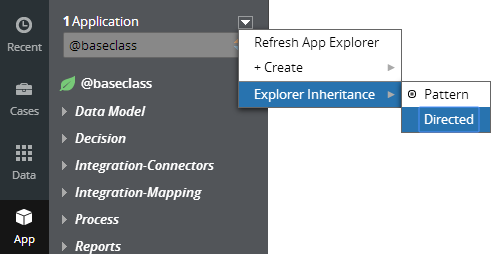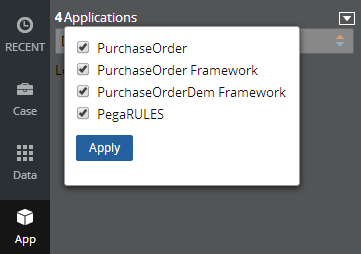Guardrails compliance score
Valid from Pega Version 7.1.5
The Application Guardrails landing page has been enhanced to help you build more guardrail-compliant applications. Increase transparency and accountability on your projects by responding to the following compliance score metrics:
- A weighted compliance score (0-100) based on warnings, severity, and justification
- A percentage of compliant rules in your application
- Total number of rules in your application
- Total number of rules in your application with warnings (justified and unjustified)
Additional metrics include alert and interaction count trends over the last four weeks.
For more information, see Guardrails compliance score.
Tracer supports SOAP messages
Valid from Pega Version 7.1.5
You can now select a Tracer Settings option to display SOAP connector and services messages in Tracer, which provides users with a better understanding of SOAP connector behavior.
Directed inheritance view in Application Explorer
Valid from Pega Version 7.1.5
You can now specify which inheritance model is used to populate classes in the Application Explorer. From the top level menu, use the “Explorer Inheritance” option to choose between:
- Pattern: only display class names whose prefix matches the root node class name.
- Directed: first display classes that explicitly name the root node as the parent class; then display classes with pattern inheritance.

By default, the Application Explorer loads using Pattern inheritance.
Actionable error message in integration wizards
Valid from Pega Version 7.1.5
Improvements have been made to the integration wizards for SOAP, SAP, and .NET that enhance the user experience by providing clearer, actionable error messages when there are problems with WSDL uploads; letting you edit the endpoint while creating or testing the integration; clarifying how the data source class layer is reused and removing confusing terms; and adding an option in Tracer to view SOAP messages generated or received by integrations.
Save Application Explorer filter selections
Valid from Pega Version 7.1.5
Application scoping control selections made in the Application Explorer are now persisted between sessions. These preferences are stored in an operator record on an access group level. If you delete (and later re-add) an access group on your operator form, the application scoping control defaults to all layers selected:

External access control DASS
Valid from Pega Version 7.1.5
A new Dynamic Admin System Setting (DASS) controls the Designer Studio's access to external systems, specifically the PDN RSS feed found on the home page.
By default, Pega-Desktop.AllowAccessToExternalSystem is set to TRUE. Update this setting to FALSE to hide the PDN RSS feed and ensure that no RSS fetch is performed.
Automate business process tracking by importing Excel files
Valid from Pega Version 8.5
To track business processes status and data, you can now import Excel files when you create a case or data object in App Studio. This functionality provides the following enhancements:
- You can now upload a CSV file when you create a case or data object in App Studio. By importing a CSV file, you can use the data in your spreadsheet to define your data model.
- You can generate a data import template that you can use to import a file in its original format during production.
- You can upload .xlsx files to avoid resaving your Excel file as a CSV file.
For more information, see Creating a data model from a spreadsheet.
Data APIs support data exploration in React UI tables
Valid from Pega Version 8.5
Data APIs have been enhanced to support filtering, sorting, paging, and aggregation in React UI tables. You can use that functionality to access your data quickly and intuitively. For example, by using paging, you can query a data page to retrieve the second page of an employee contact list and specify the number of results that are displayed on the page.
For more information, see Data API performance and limitations.
Support for application-specific REST API calls
Valid from Pega Version 8.5
You can now call an authenticated REST API in the context of any application that is listed on an operator record by using the application alias URL. With the application alias URL, you can also develop REST services without changing the access group in the service package. REST services run in the context of the access group that points to the provided application, instead of the access group that is specified in the service package.
For more information, see Invoking a REST service rule.
Business logic-based routing cards enhancements
Valid from Pega Version 8.5
To ensure that the sequence of business logic-based routing cards conforms to your business requirements, you now have the option to change the order of the cards. For easier navigation across multiple routing cards, the system automatically collapses the cards for you, and you can then easily expand the cards that you need to display.
For more information, see Navigate easier across business logic-based routing cards (8.5), Assigning users automatically at run time.

